Field Guide: Morphometric Visualization and Characterization of Selected Foodborne Pathogens Using Advanced Imaging Techniques
Abstract
1. Introduction
2. Materials and Methods
2.1. Instrumentations
2.2. Sample Preparation for 3D Measurements and Imaging
2.3. Sample Preparation for Transmission Electron Microscope (TEM) Imaging
2.4. Sample Measurement
2.5. Statistical Analysis
2.6. Morphometrics
3. Results and Field Guide Dichotomous Classification
4. Conclusions
Author Contributions
Funding
Institutional Review Board Statement
Data Availability Statement
Acknowledgments
Conflicts of Interest
References
- Centers for Disease Control and Prevention (CDC). Estimates of Foodborne Illness in the United States. 2018. Available online: https://www.cdc.gov/foodborneburden/index.html (accessed on 1 December 2024).
- World Health Organization (WHO). WHO Estimates of the Global Burden of Foodborne Diseases. 2015. Available online: https://www.who.int/publications/i/item/9789241565165 (accessed on 27 November 2024).
- Scallan, E.; Hoekstra, R.M.; Angulo, F.J.; Tauxe, R.V.; Widdowson, M.A.; Roy, S.L.; Jones, J.L.; Griffin, P.M. Foodborne illness acquired in the United States—Major pathogens. Emerg. Infect. Dis. 2011, 17, 7–15. [Google Scholar] [CrossRef] [PubMed]
- Gould, L.H.; Walsh, K.A.; Vieira, A.R.; Herman, K.; Williams, I.T.; Hall, A.J.; Cole, D. Surveillance for foodborne disease outbreaks—United States, 1998–2008. Morb. Mortal. Wkly. Rep. 2013, 62, 1–34. Available online: https://www.cdc.gov/mmwr/preview/mmwrhtml/ss6202a1.htm (accessed on 12 December 2024).
- Bridier, A.; Sanchez-Vizuete, P.; Guilbaud, M.; Piard, J.C.; Naïtali, M.; Briandet, R. Biofilm-associated persistence of food-borne pathogens. Food Microbiol. 2015, 45, 167–178. [Google Scholar] [CrossRef] [PubMed]
- Dassanayake, R.P.; Falkenberg, S.M.; Stasko, J.A.; Shircliff, A.L.; Lippolis, J.D.; Briggs, R.E. Identification of a reliable fixative solution to preserve the complex architecture of bacterial biofilms for scanning electron microscopy evaluation. PLoS ONE 2020, 15, e0233973. [Google Scholar] [CrossRef]
- Le, P.H.; Nguyen, D.H.; Aburto-Medina, A.; Linklater, D.P.; Crawford, R.J.; MacLaughlin, S.; Ivanova, E.P. Nanoscale surface roughness influences Candida albicans biofilm formation. ACS Appl. Bio Mater. 2020, 3, 8581–8591. [Google Scholar] [CrossRef] [PubMed]
- Gahan, C.G.; Hill, C. The relationship between acid stress responses and virulence in Salmonella typhimurium and Listeria monocytogenes. Int. J. Food Microbiol. 1999, 50, 93–100. [Google Scholar] [CrossRef] [PubMed]
- Rayat, C.S.; Rayat, C.S. Applications of Microsoft Excel in statistical methods. In Applications of Microsoft Excel in Statistical Methods; Springer: Singapore, 2018; pp. 139–146. [Google Scholar]
- KEYENCE International Belgium. (n.d.). Area roughness parameters. Str (Texture aspect ratio)|Area Roughness Parameters|Surface Roughness Parameters in ISO 25178|List of Parameters Useful for Design/Inspection Other than Sa and Sz|Solving the Questions About Profile and Surface Roughness Measurements! Introduction to “Roughness”. Available online: https://www.keyence.eu/ss/products/microscope/roughness/surface/tab02_b.jsp#:~:text=This%20parameter%20expresses%20the%20isotropy,does%20not%20depend%20on%20directions (accessed on 12 December 2024).
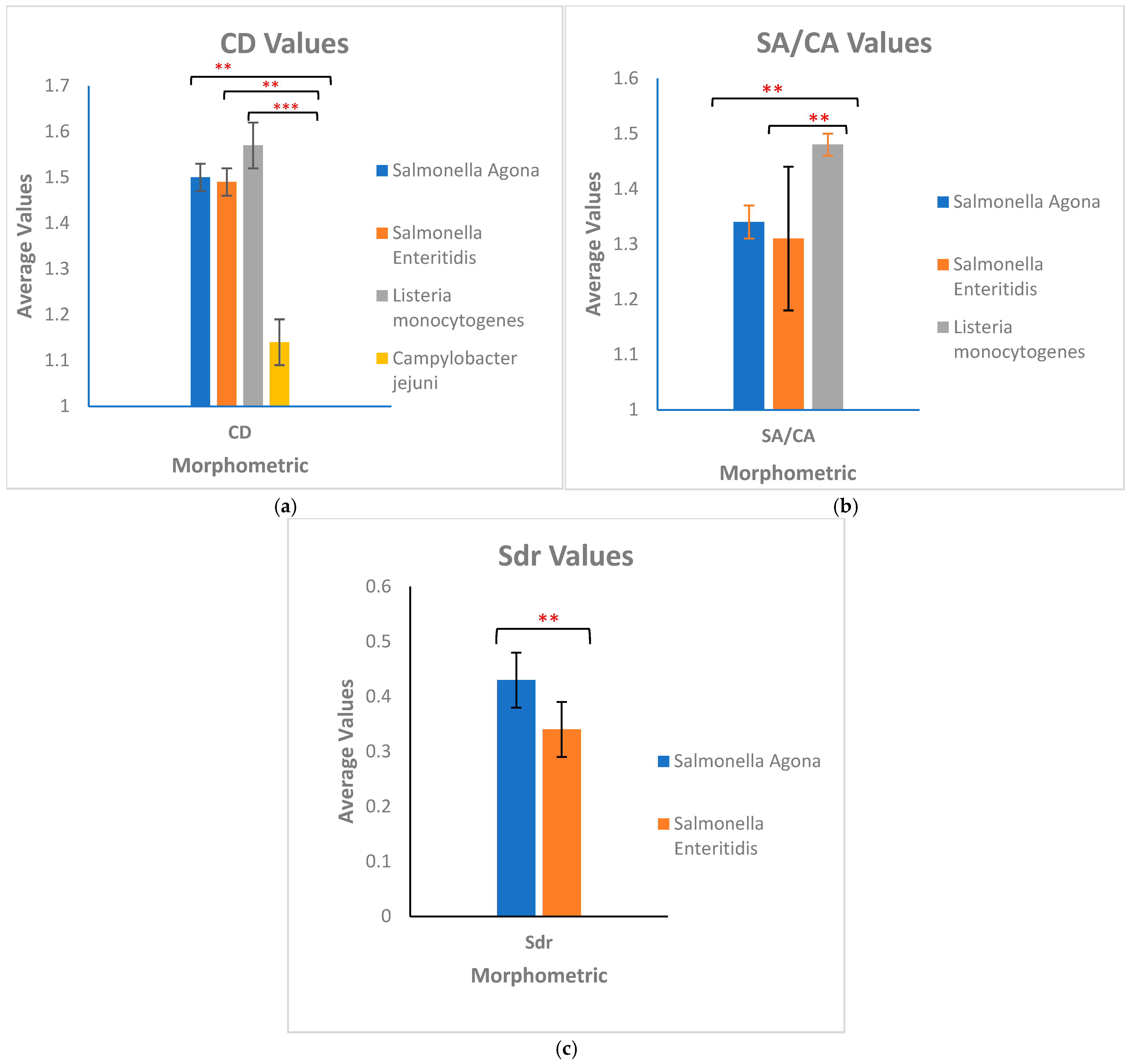
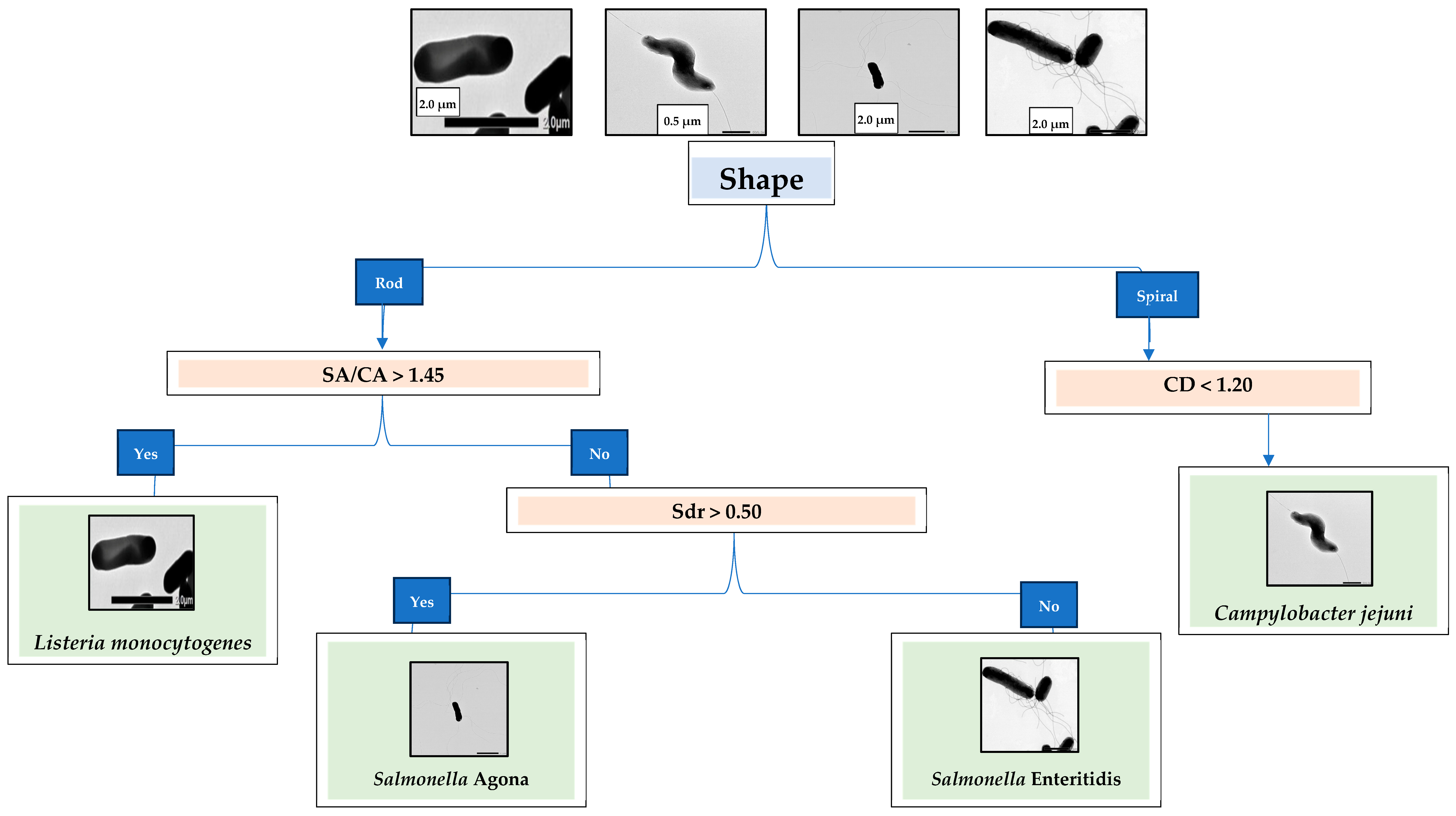
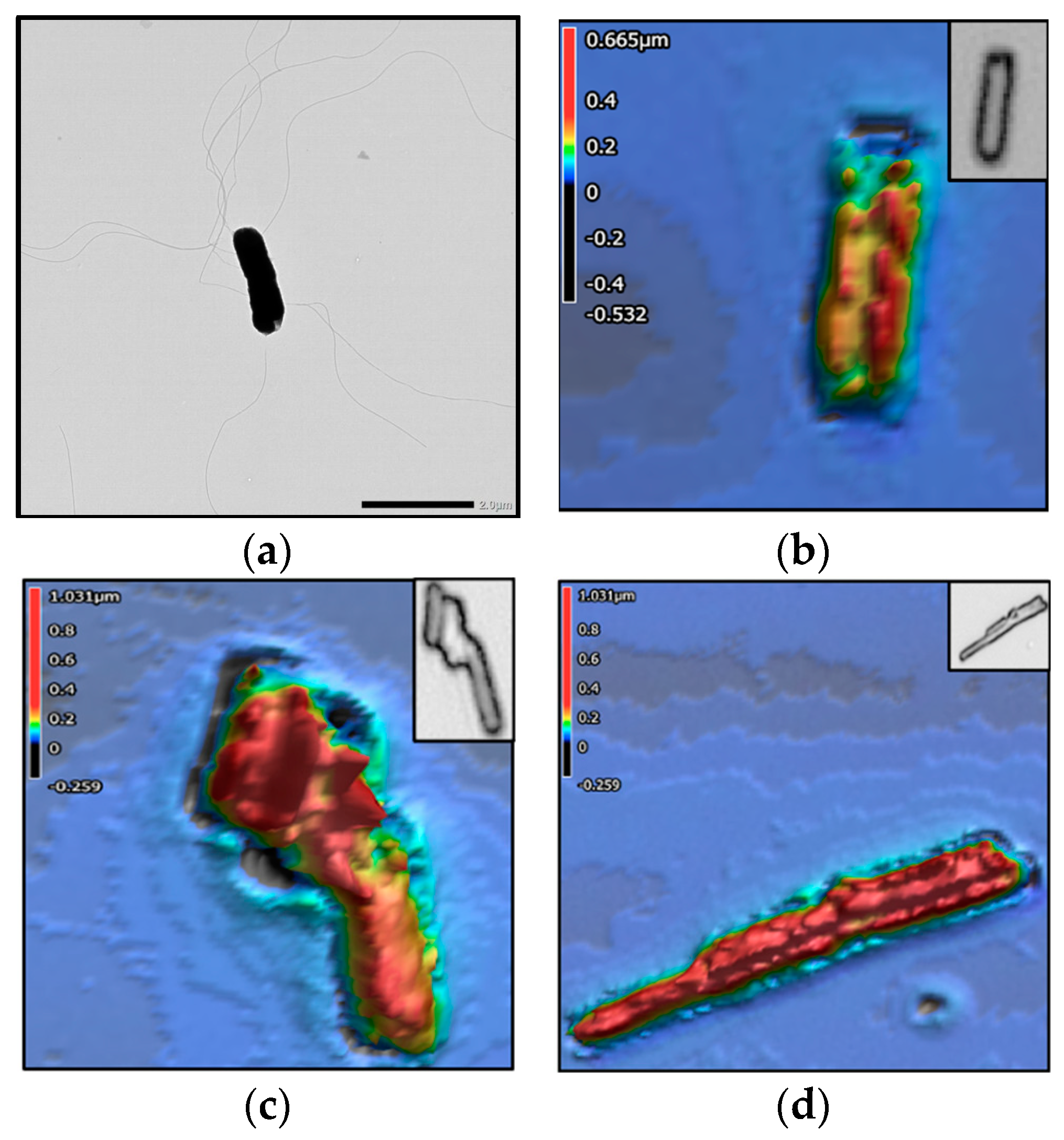

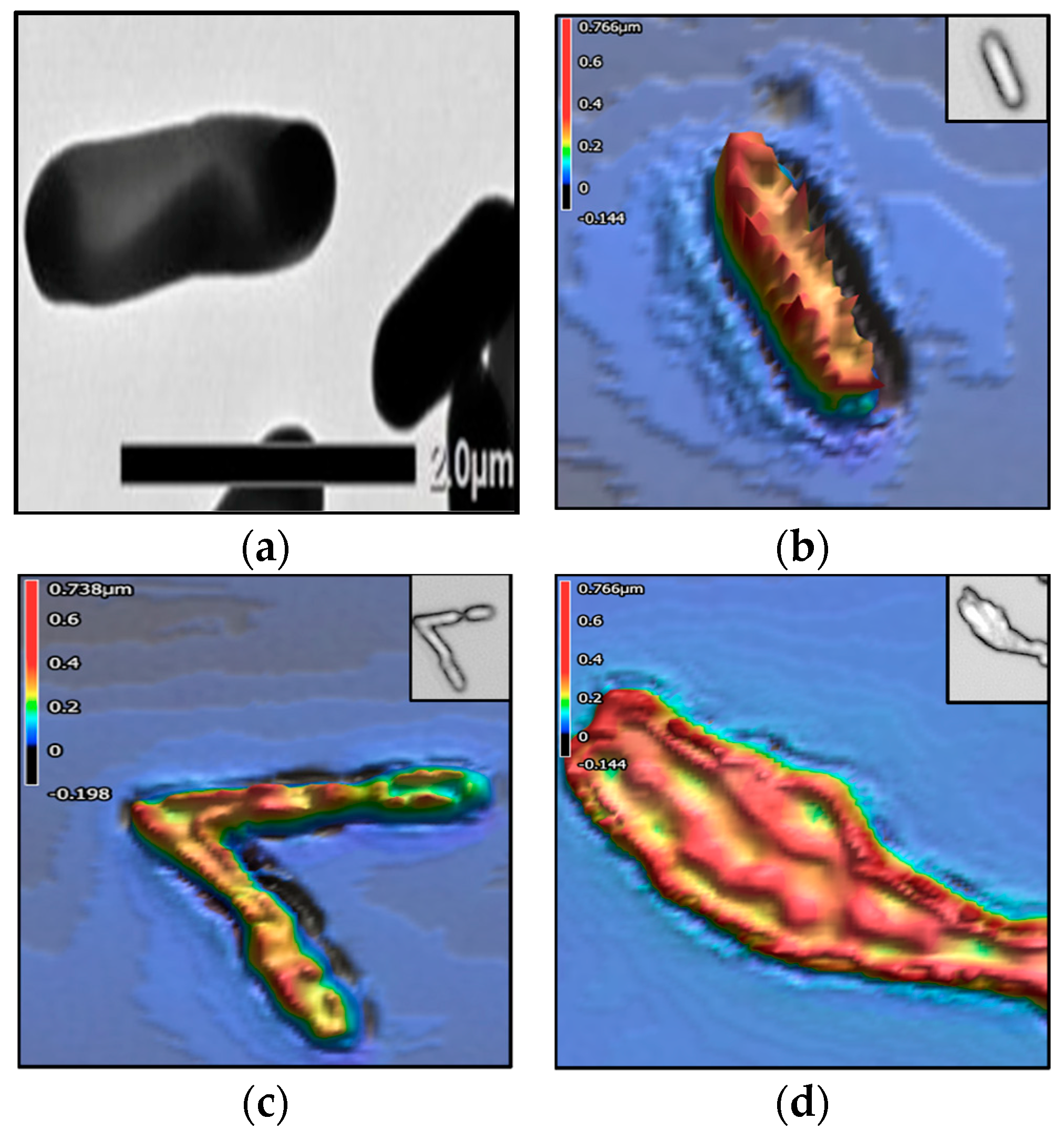
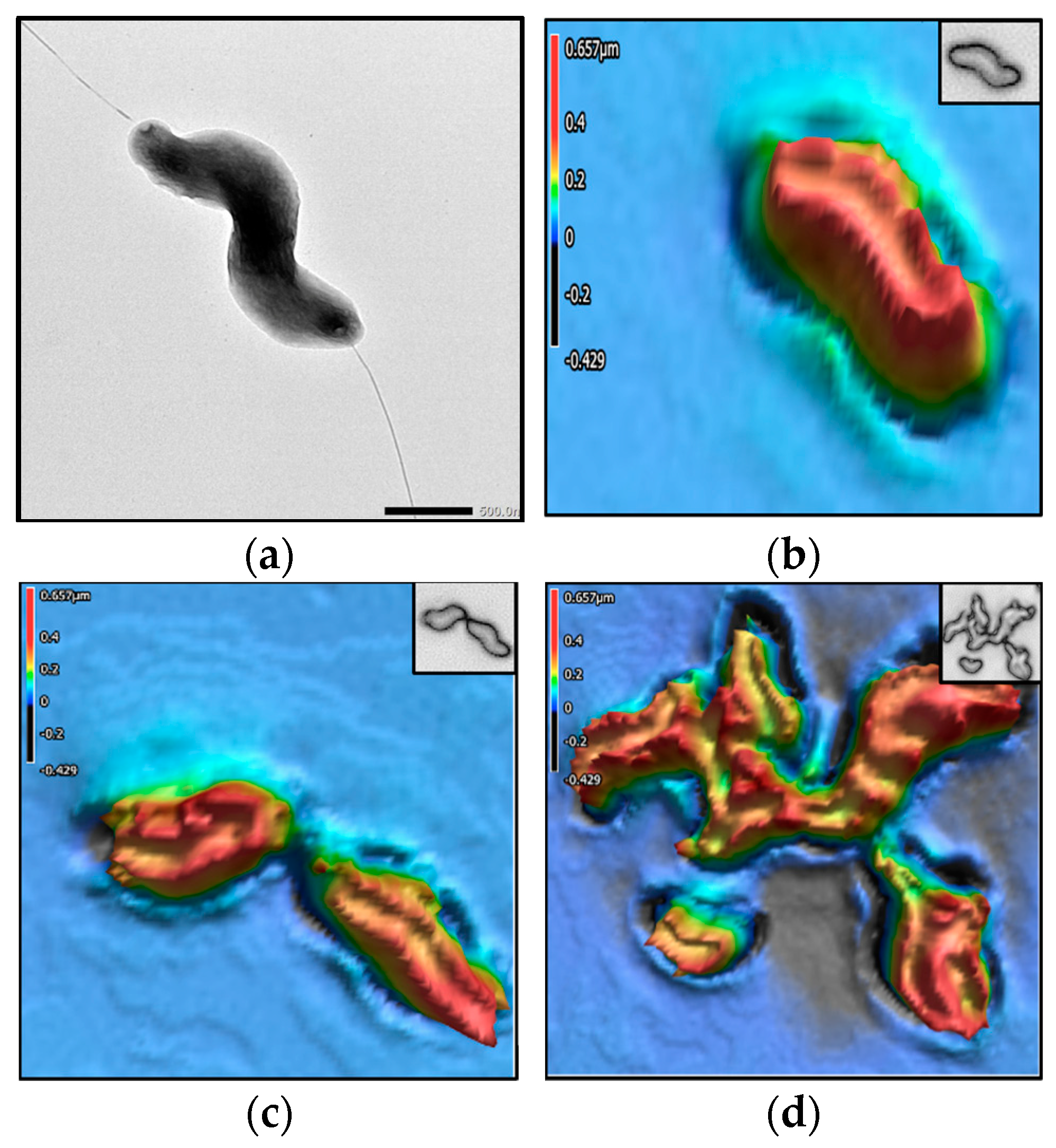
| Morphometrics | Salmonella enterica serovar Agona | Salmonella enterica serovar Enteritidis | Listeria monocytogenes | Campylobacter jejuni |
|---|---|---|---|---|
| Length (L, µm) | 2.05 ± 0.23 | 2.36 ± 0.61 | 1.85 ± 0.56 | 1.35 ± 0.12 |
| Width (W, µm) | 1.37 ± 0.10 | 1.50 ± 0.37 | 1.77 ± 0.27 | 1.11 ± 0.06 |
| Circle Diameter (CD, µm) | 1.50 ± 0.03 | 1.49 ± 0.03 | 1.57 ± 0.05 | 1.14 ± 0.05 |
| Volume (V, µm3) | 0.72 ± 0.07 | 0.97 ± 0.49 | 0.93 ± 0.05 | 0.47 ± 0.08 |
| Surface Area/Cross-Sectional Area (SA/CA) | 1.36 ± 0.03 | 1.31 ± 0.13 | 1.48 ± 0.02 | 1.42 ± 0.06 |
| Surface Uniformity (Str) | 0.43 ± 0.03 | 0.41 ± 0.16 | 0.34 ± 0.03 | 0.51 ± 0.03 |
| Surface Texture (Sdr) | 0.43 ± 0.05 | 0.34 ± 0.18 | 0.57 ± 0.05 | 0.48 ± 0.17 |
Disclaimer/Publisher’s Note: The statements, opinions and data contained in all publications are solely those of the individual author(s) and contributor(s) and not of MDPI and/or the editor(s). MDPI and/or the editor(s) disclaim responsibility for any injury to people or property resulting from any ideas, methods, instructions or products referred to in the content. |
© 2025 by the authors. Licensee MDPI, Basel, Switzerland. This article is an open access article distributed under the terms and conditions of the Creative Commons Attribution (CC BY) license (https://creativecommons.org/licenses/by/4.0/).
Share and Cite
Al Hafi, L.; Franco, A.J.; Kao, K.; Alocilja, E.C. Field Guide: Morphometric Visualization and Characterization of Selected Foodborne Pathogens Using Advanced Imaging Techniques. Encyclopedia 2025, 5, 47. https://doi.org/10.3390/encyclopedia5020047
Al Hafi L, Franco AJ, Kao K, Alocilja EC. Field Guide: Morphometric Visualization and Characterization of Selected Foodborne Pathogens Using Advanced Imaging Techniques. Encyclopedia. 2025; 5(2):47. https://doi.org/10.3390/encyclopedia5020047
Chicago/Turabian StyleAl Hafi, Ladees, Anthony James Franco, Kaily Kao, and Evangelyn C. Alocilja. 2025. "Field Guide: Morphometric Visualization and Characterization of Selected Foodborne Pathogens Using Advanced Imaging Techniques" Encyclopedia 5, no. 2: 47. https://doi.org/10.3390/encyclopedia5020047
APA StyleAl Hafi, L., Franco, A. J., Kao, K., & Alocilja, E. C. (2025). Field Guide: Morphometric Visualization and Characterization of Selected Foodborne Pathogens Using Advanced Imaging Techniques. Encyclopedia, 5(2), 47. https://doi.org/10.3390/encyclopedia5020047







